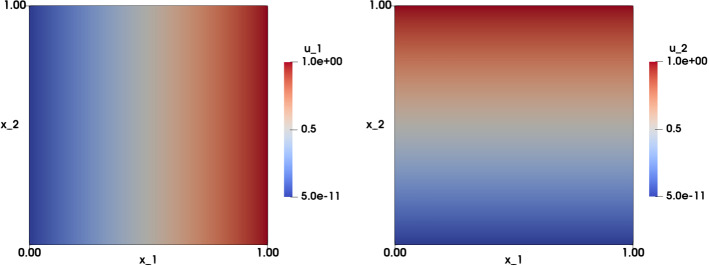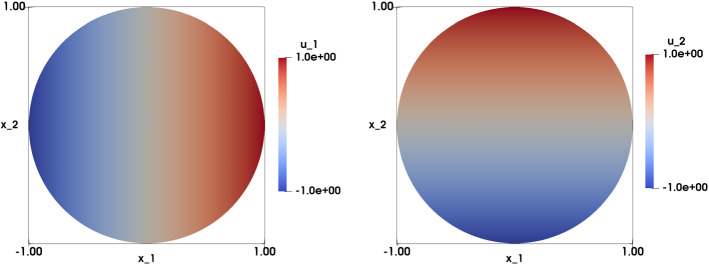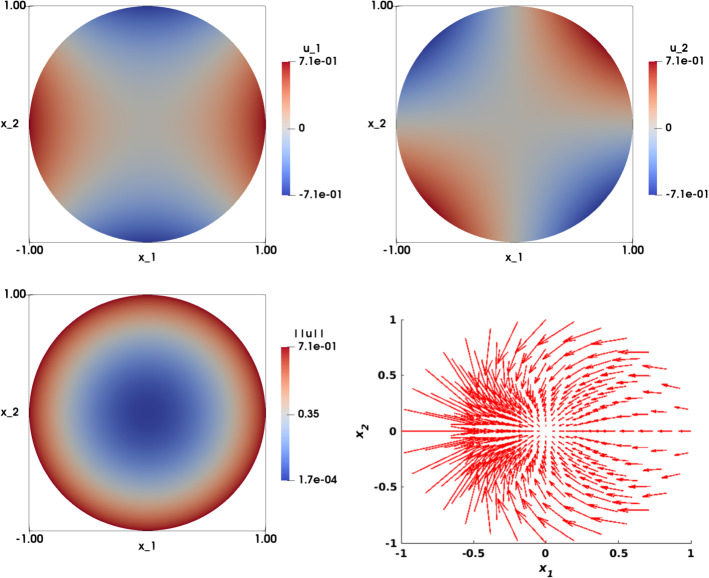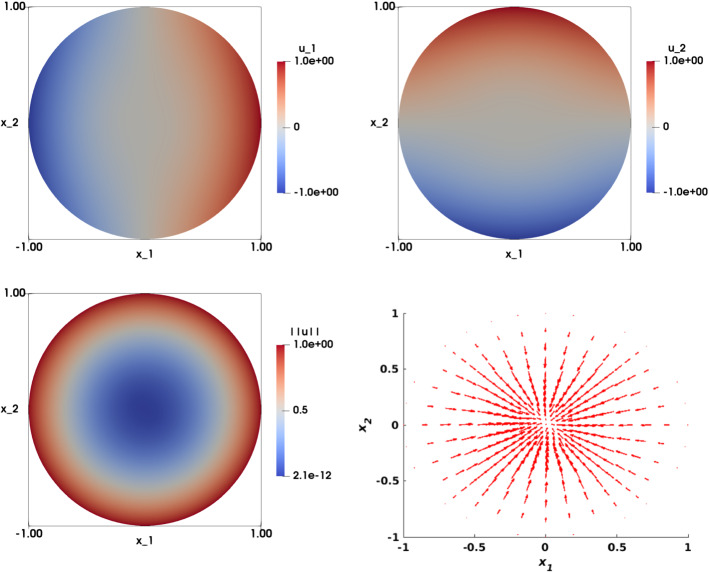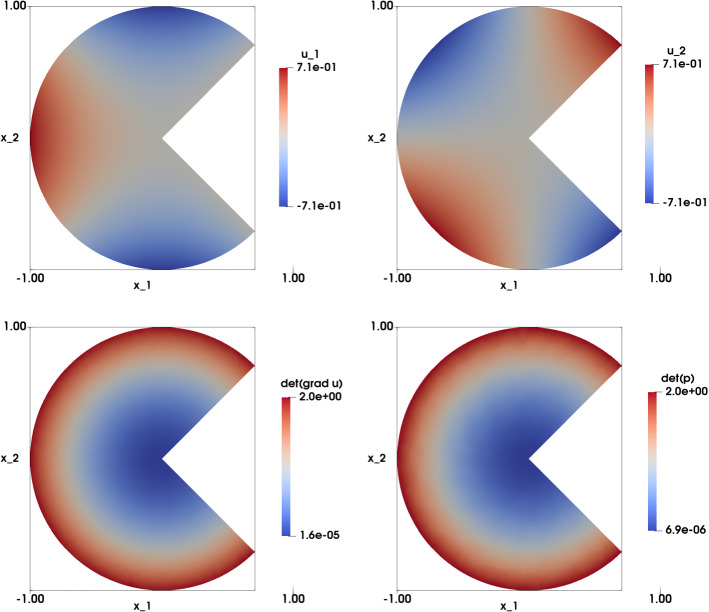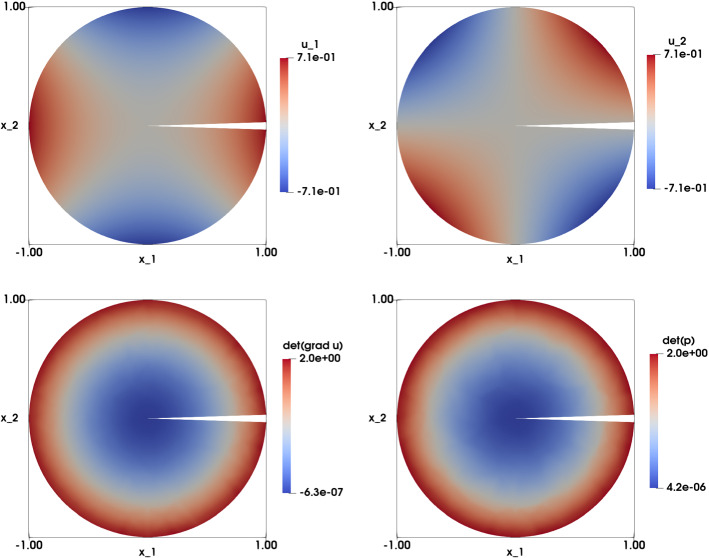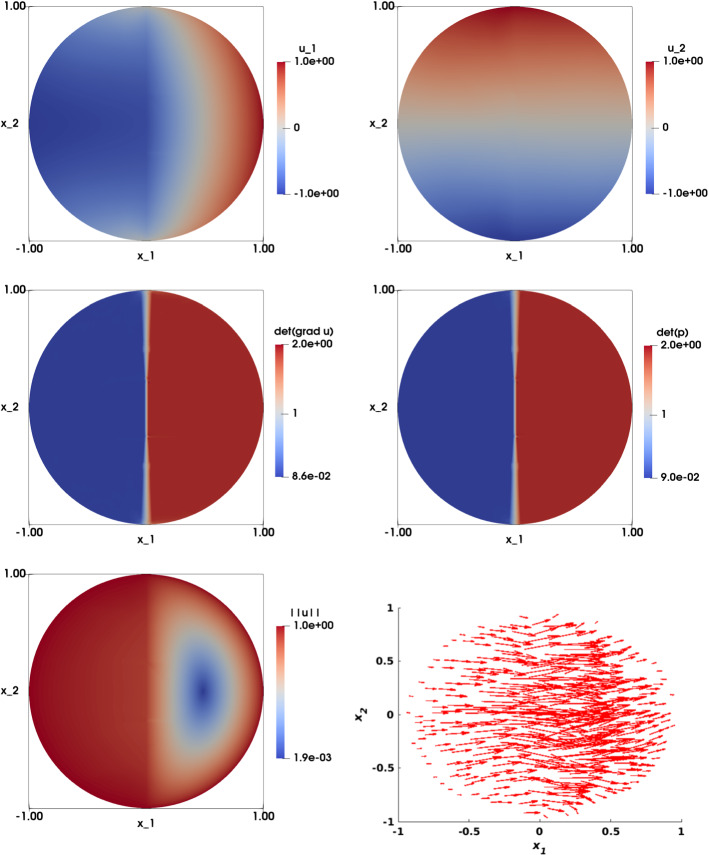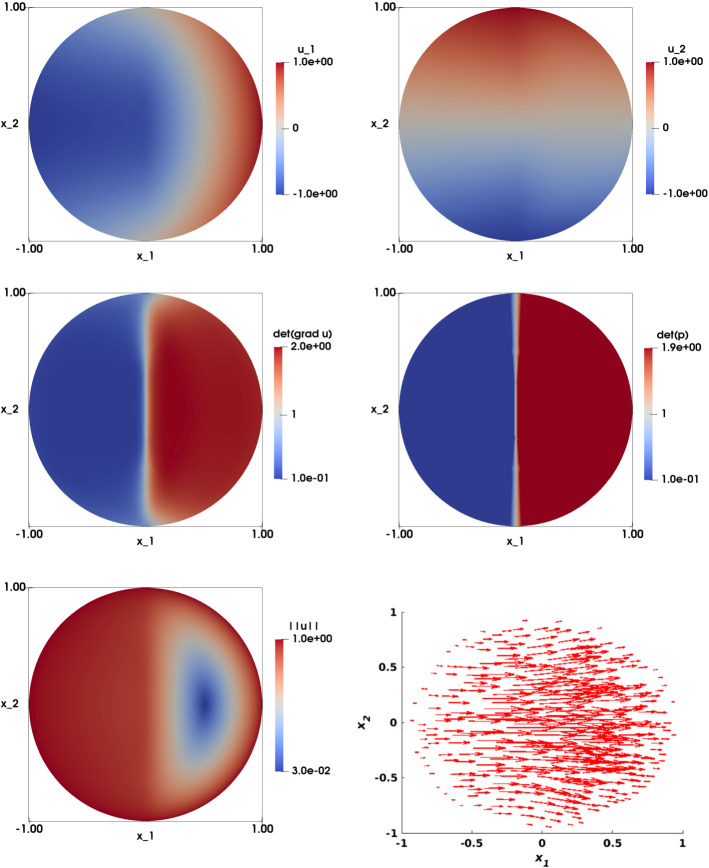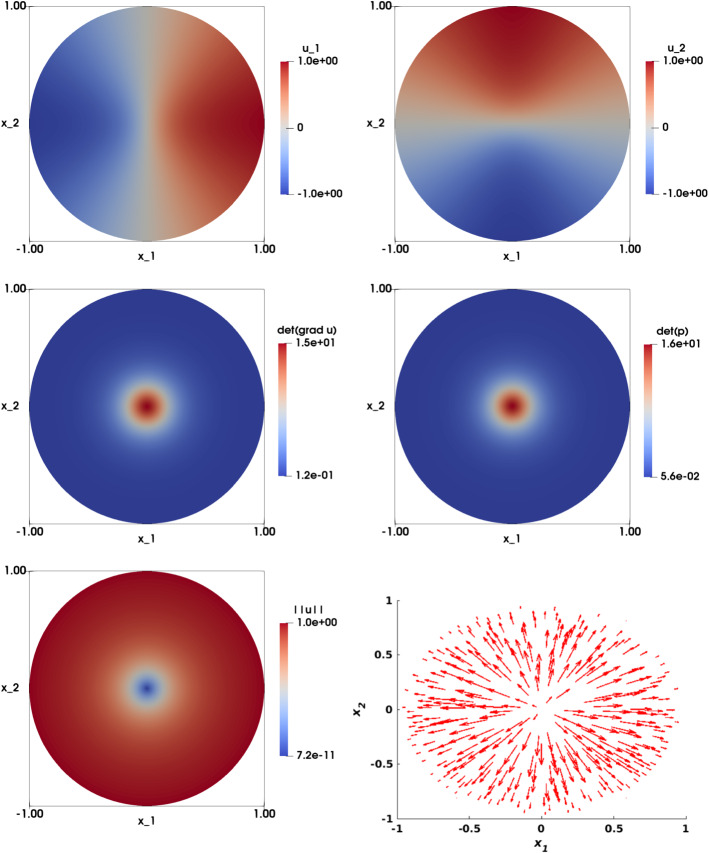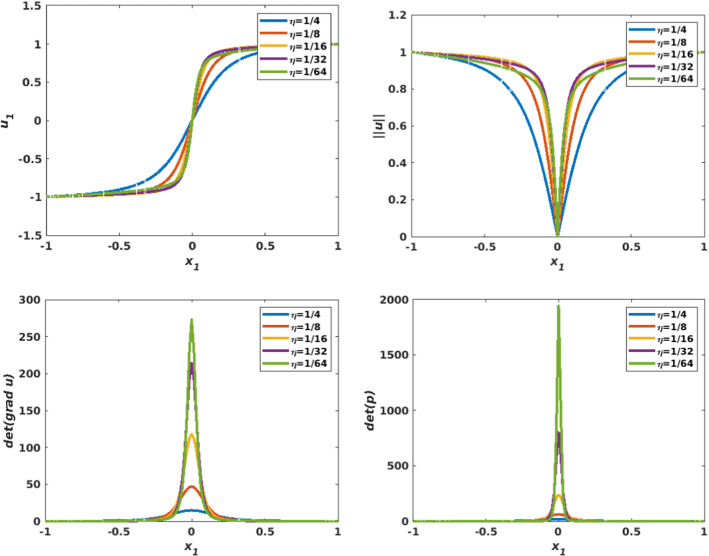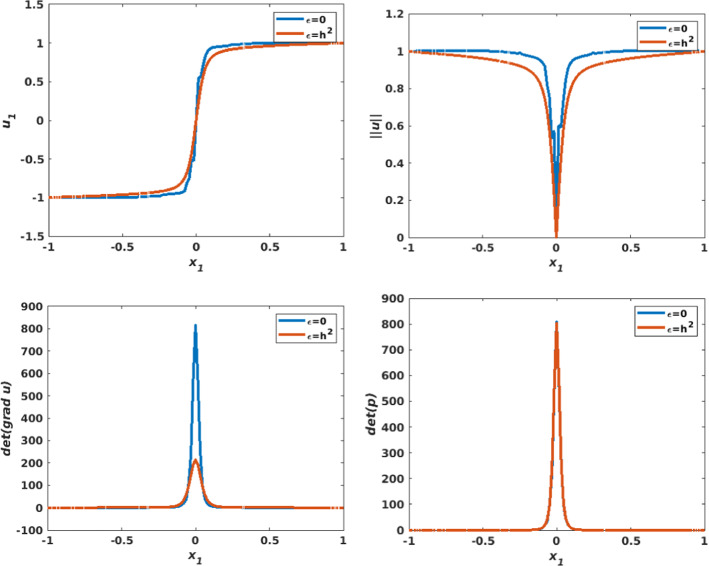Abstract
We consider a least-squares/relaxation finite element method for the numerical solution of the prescribed Jacobian equation. We look for its solution via a least-squares approach. We introduce a relaxation algorithm that decouples this least-squares problem into a sequence of local nonlinear problems and variational linear problems. We develop dedicated solvers for the algebraic problems based on Newton’s method and we solve the differential problems using mixed low-order finite elements. Various numerical experiments demonstrate the accuracy, efficiency and the robustness of the proposed method, compared for instance to augmented Lagrangian approaches.
Keywords: Jacobian determinant, Least-squares method, Newton methods, Biharmonic regularization, Finite element method, Nonlinear constrained minimization
Introduction
Numerical methods for fully nonlinear equations have recently started to receive a lot of attention, the most well-known equation in that category being the so-called Monge-Ampère equation. Various approaches have been proposed for the numerical solution of second order fully nonlinear equations: the Monge-Ampère equation, see, e.g. [1–6], but also the Pucci’s equation [7–9] or the curvature equation [10, 11].
First order fully nonlinear equations have received slightly less attention: we can mention here the Eikonal equation [12, 13], or the Hamilton-Jacobi equation [14], which have several applications in optics, wave propagation, material science, differential geometry (geodesics), or even economics [15].
The problem of interest here is a particular equation involving the Jacobian of the unknown function, which has been introduced by Dacorogna and Moser (1990) [16]. More precisely, we consider here a Dirichlet boundary value problem inspired by [16–18], which states that, for a given data f, we want to find a vector field satisfying in a bounded domain (together with appropriate Dirichlet boundary conditions). A special interest is paid to problems for which the data f is non-smooth. Several works in the literature have focused on this prescribed Jacobian equation, starting with the seminal article [16], which has been developed and extended in, e.g., [17, 19–25]. Existence of classical solutions rely on solutions in Hölder spaces [16]. Weak solutions to the prescribed Jacobian equation must be considered in the sense of Aleksandrov [26], as emphasized, e.g., in [27, 28]. This problem is linked to the Monge-Ampère equation if considering the case where the vector function is the gradient of a scalar function , as becomes . Another related problem in incompressible elasticity has been addressed in [29] (see also the references therein), where the incompressibility condition reads as , being the identity tensor and the unknown displacement field.
Theoretical solutions, obtained with explicit constructions, exist in the literature for cases in simple geometries, and usually with identity boundary conditions. However, numerical methods for this particular problem are rather scarce. The goal of the present article is to design a numerical method for the finite element approximation of the prescribed Jacobian equation for arbitrary two-dimensional domains, including non-convex domains and non-smooth data.
A first methodology has been proposed in [30, 31] by using an Alternating Direction Method of Multipliers (ADMM) approach. The numerical algorithm has proved to be efficient, but requires a tedious fine tuning of parameters.
Following previous works on the Monge-Ampère equation [1, 32], we advocate here a variational approach for the solution of the prescribed Jacobian equation that is based on a least-squares approach. In order to decouple the nonlinearities of the problem from the linear variational aspects, we use a relaxation algorithm. Low order finite elements are used for the space discretization, while mathematical programming methods [33] allow to solve local constrained optimization problems. Equality constraints are taken into consideration via a Lagrangian approach.
In order to demonstrate the flexibility of the proposed method, we also consider in addition the prescribed Jacobian inequality. The, strongly underdertemined, problem consists in finding a vector field satisfying instead of (together with appropriate Dirichlet boundary conditions). Theoretical results of the prescribed Jacobian inequality are given, e.g., in [34], and to the best of our knowledge there are no proposed numerical methods to solve this type of inequality. It will be addressed by, e.g., including interior-point methods [33].
The numerical validation is achieved first via the solution of test problems allowing a computational investigation of the convergence properties of our methodology. The treatment of more demanding test problems associated with non-smooth data and/or non-convex domains, allows to investigate the accuracy and the robustness of the proposed methodology.
The Mathematical Problem
Let be a bounded domain of . We denote by the boundary of . Let and be given sufficiently smooth functions. The partial differential equation involving the Jacobian determinant we want to solve reads as follows: find satisfying
| 1 |
Generally, we assume that . This problem has been originally investigated in [16] from a theoretical point of view, when the boundary condition is the identity function (i.e. for ). The corresponding problem is of the following type:
| 2 |
Problem (2) corresponds to finding a mapping that preserves both the boundary data and some kind of volume (up to some stretching of the mapping). These problems have been addressed in [30, 31] with a numerical approach based on augmented Lagrangian techniques. We will provide here an alternative, more robust, numerical method, based on a least-squares approach.
Note that the solution to (2) is not necessarily unique and the same remark holds for (1). Indeed, let us consider (2) with and the unit disk centered at the origin; in this case, is an obvious solution. But, when using the polar coordinates , one can see that defined by is also a solution.
The proof of the existence of a solution to (1) (via the divergence theorem) requires data to be compatible with the geometrical domain, see [16]. When the boundary conditions are given by on , this compatibility condition reads as:
| 3 |
The positiveness of the right-hand side f is useful from an analytical point of view to prove existence results. Moreover, it makes problem (1) an elliptic problem, which is important for the solution methodology discussed in this article. However, it has been loosened (slightly) to accept locally negative data (see, e.g., [17]). From now on we will assume that (3) holds.
Originally, the regularity of (classical) solutions in Hölder spaces can be found in [16]. In order to derive such regularity results and obtain classical solutions in , the regularity needed on the data is , together with and the compatibility condition (3). Moreover, existence results require that the regularity of the domain is has to be .
On the other hand, weak solutions to the generated Jacobian equation must be considered in the Aleksandrov-sense [26–28, 35, 36]. The derivation and proofs are similar to the approach for solutions to the Monge-Ampère equation, see, e.g., [2]. As stated earlier, the relationship between the Monge-Ampère equation and the Jacobian equation is explicit, by setting [22]. It is thus not surprising to find similar concepts of weak solutions.
The proposed method allows to find a finite element approximation in a least-squares sense. As in [1, 32], there is no evidence that the discrete solution is converging to an Aleksandrov-type of solution. However, experiments have exhibited a strong numerical evidence of a convergent behavior of the approximations when the discretization parameters tend to zero.
Remark 1
(Jacobian problem with inequalities) In parallel, we consider the following partial differential inequality : find satisfying
| 4 |
with again, in particular, the case of the identity boundary condition (i.e. for ). This problem has been addressed in [34] where existence results are established under the condition
| 5 |
We will show in the sequel that the numerical techniques developed for (1) also apply naturally to (4), with small modifications.
A Numerical Algorithm
We advocate a numerical algorithm based on a least-squares approach and a relaxation algorithm. The relaxation algorithm allows to split the minimization problem into a sequence of subproblems. The first subproblem consists of low dimensional local nonlinear problems, the number of them being determined from the chosen mesh grid. The second subproblem is a linear variational problem and it results in a fourth-order partial differential equation.
A Least-Squares Method
Let us define
We assume that f and g are sufficiently smooth, so that and are non-empty. The least squares problem introduces an auxiliary variable , and reads as follows: find such that
| 6 |
where is defined by
| 7 |
Here denotes the Frobenius norm , with the inner product where are matrices with elements , for , respectively.
We propose a biharmonic regularization of the objective function. The added term is motivated by previous works involving first-order elliptic equations, see [12, 31, 37]. The modified objective function is defined as
| 8 |
where . Numerical experiments will illustrate that the biharmonic regularization allows to accelerate the convergence of the numerical algorithm. The modified minimization problem reads as: find such that
| 9 |
where .
Remark 2
(Jacobian problem with inequality) In the case of the inequality (4), we modify the functional space as
The objective function remains the same as in (8), and the minimization problem reads as: find such that
| 10 |
A Relaxation Algorithm
For the solution of (9) and (10) respectively, we propose the following relaxation algorithm:
- When is known, we look for
12 - When is known, we look for
13 - When is known, we update the solution by
where is a relaxation parameter that helps controlling the convergence speed.14
Remark 3
(Jacobian problem with inequality) For the Jacobian inequality (4), the solution can be found by replacing in (12) the functional space by defined in (10).
Numerical Solution of the Local Nonlinear Problems
We focus here on the solution of (12). Since is known, the solution is obtained by solving the minimization problem
| 15 |
Problem (15) can be solved point-wise since it does not involve any derivative for the variable . The solution can be obtained, locally for all , as
| 16 |
where , and . Following [29, 31], we reduce the dimension of the problem with a proper change of variables. Let us introduce the vectors , and and the matrix
By introducing the new variables and , (16) is equivalent to
| 17 |
with . In order to solve (17), we introduce the Lagrangian functional defined by:
| 18 |
Let denote the solution of (17), with the corresponding Lagrange multiplier. The first order optimality conditions read:
| 19 |
After elimination, (19) can be solved by a (scalar) Newton method to find first, and then the primal variables. Moreover, we target a solution that is close to zero. Indeed, if , then , , and the last equation of (19) reads as
and therefore is the solution of (1) and . Numerical experiments will show that, in practise, the solution for is close to zero.
When considering the Jacobian inequality (4), the solution of the minimization problem, for all , reads as
| 20 |
where and . In order to solve (20), we can introduce a slack variable and re-write the problem as
| 21 |
Then, a logarithmic barrier function allows to eliminate the inequality constraint (see e.g. [33]):
| 22 |
where . The minimization problem (22) is similar to (16). Its solution will be implemented with the same approach, relying on the same change of variables, the Lagrangian functional, and its first order optimality conditions, which are solved with a Newton method.
Numerical Solution of the Linear Variational Problems
We focus here on the solution of (13), which is equivalent to solving:
| 23 |
We derive the first optimality conditions and obtain a fourth order partial differential equation: find such that
| 24 |
for all .
Finite Element Approximation
Let be a space discretization step and let be family of conformal triangulations of (see [38, Appendix 1]). Let be defined as
equipped with the discrete inner product and corresponding norm:
Let be the finite dimensional subsets approximating and , respectively defined by
where . Let be the finite dimensional subspaces of given by
where the space of the two-variable polynomials of degree , and is a piecewise linear interpolant of . We define a discrete inner product and corresponding norm for and as
with the weights and the evaluation points of a Gauss quadrature rule, m denoting the number of points of the quadrature rule.
The discrete formulation of the least-squares method to solve (9) reads as follows: find such that
Remark 4
(Jacobian problem with inequalities) Similarly, the discrete formulation of the least-squares method to solve (10) reads as follows: find such that
The discrete formulation of the relaxation algorithm (11)–(14) described in Sect. 3.2 becomes the following:
- We initialize the algorithm by finding such that:
where for all . Then, for ,25 - We solve the discrete local nonlinear problem:
When considering the Jacobian problem with inequality constraints (4), we replace by in (26). The solution of the discrete minimization problem (26), , is obtained on each element T of , in an identical manner as the solution of the continuous problem described in Sect. 3.3.26 - We solve the discrete linear variational problem:
The first order optimality conditions read: find satisfying
for all . By applying a mixed finite element method to (27), we solve an equivalent augmented system of equations: find such that,27
for all . - We update the solution by:
Numerical Experiments
We validate the convergence and accuracy of the proposed least-squares method with various numerical experiments. We consider several domains, namely the unit square , the unit disk , the so-called ’pacman’ domain
and the cracked unit disk
Figure 1 illustrates typical triangulations of these domains. For coarse meshes, we initialize the algorithm by solving (25) with given boundary data. For finer meshes, we initialize the algorithm by using the numerical solution obtained on a coarser mesh. In all experiments, (unless specified otherwise). The relaxation parameter is initially, and then gradually increases to . The stopping criterion for the relaxation algorithm is . The Newton’s method to solve the local nonlinear problems stops when the difference between two successive iterations is smaller than . Usually, this number of iterations does not exceed 5. The interior-point parameter is specified later.
Fig. 1.
Finite element meshes used for the numerical experiments. Top left: structured mesh for the unit square (, ); Top middle: unstructured mesh for the unit square (, ); Top right: structured mesh for the unit disk (, ); Bottom left: unstructured mesh for the unit disk (, ); Bottom middle: unstructured mesh for the pacman domain (, ); Bottom right: unstructured mesh for the cracked unit disk (, )
The estimation of is denoted by , and is obtained by averaging its values on each triangle, for each triangle . It is accompanied by the standard deviation of the estimator, , to describe the variability over the mesh elements. These indicators are:
where N is the number of triangles of the triangulation .
Numerical Approximation of the Identity Map
The first experiment corresponds to considering the identity map as the exact solution. The data are chosen as and on . The problem can be written as: find such that:
| 28 |
When , we use structured meshes with mesh size , The errors for the obtained approximations are of order in the error norm, and of order to in the error norm. In addition, and are of the order of . Figure 2 illustrates the approximation on the structured mesh of the two components of the numerical solution. More precisely, with , after 29 iterations, we obtain
and
When , we use structured meshes with mesh size . Similar to when working on the unit square, the errors for the approximations are again of order in the error norm, and of order to in the error norm. Furthermore, and are of the order of to . In particular, for , and after 29 iterations, we obtain
and
Figure 3 illustrates the approximation of the two components of the numerical solution on the structured mesh of the unit disk.
Fig. 2.
Identity map test case on the unit square with data and . Visualization of the numerical approximation of the solution . Left: the component ; Right: the component . Results are obtained on a structured mesh with
Fig. 3.
Identity map test case on the unit disk with data and . Visualization of the numerical approximation of the solution . Left: the component ; Right: the component . Results are obtained on a structured mesh with
Then, the algorithm is tested by considering the inequality problem (4). We consider the following problem (, and ):
| 29 |
There is some information missing in (29) since , and the only available relevant information on the solution comes from the boundary conditions. The algorithm converges to an exact solution , in a similar fashion as for (28). Actually the solution obtained when solving (29) is similar to the one obtained by solving (28).
In this test case we choose and we decrease it with a factor of at each iteration. By contrast to solving the Jacobian equality in (28), numerical errors in and norms of solving the inequality (29) using the same mesh size values are of the order of and , respectively. These parameters depend on the choice of : if initially is chosen to be large, will be also large; if is small, we experience some convergence problems. When considering , we obtain after 69 iterations:
and
Smooth Solution with Radial Right-Hand Side
Let be the unit disk. We consider the following problem: find such that:
| 30 |
where
| 31 |
One exact solution satisfies
| 32 |
The non-uniqueness of the solution of Eq. (30) makes this test case challenging. For instance, this may cause the algorithm to fluctuate between two different solutions. Later on, we show that our algorithm converges to a solution for different sets of parameters. The numerical solution of (30) is illustrated in Fig. 4 (top row). Note that both the right-hand side of this equation and (bottom left), are radial symmetric. However, the solution does not exhibit the same symmetry pattern.
Fig. 4.
Smooth solution with radial right-hand side test case ( and on ). Top left: Numerical approximation of the solution of the component . Top right: Numerical approximation of the solution of the component . Bottom left: Visualization of . Bottom right: Visualization of the vector field . The results are obtained on structured mesh of the unit disk with
Table 1 provides insights about the convergence of the relaxation algorithm towards the numerical solution on the structured mesh for the unit disk. The only difference with the results presented in the previous section is that the numerical solution converges in -norm with a nearly optimal rate of to , and in semi-norm with an optimal rate of . Similar results are observed in Table 2, where the unstructured mesh is used. We observe that the numerical solution converges in -norm and -semi norm with rates of and O(h), respectively. This confirms that the behavior of the algorithm does not depend on the structure of the mesh.
Table 1.
Smooth solution with radial right-hand side test case. The case of the unit disk with a structured mesh. ( and on ). Computational results include the mesh size h, the and error norms with the corresponding rates, the error , the average value and its standard deviation , and the number of iterations of the relaxation algorithm
| h | iter | ||||||
|---|---|---|---|---|---|---|---|
| 0.0831 | 5.95e03 | 2.14e01 | 9.05e02 | 1.37e02(0.063) | 19 | ||
| 0.0421 | 1.27e03 | 2.19 | 1.03e01 | 1.05 | 4.25e02 | 7.50e03(0.036) | 39 |
| 0.0209 | 3.38e04 | 1.91 | 5.22e02 | 0.98 | 2.17e02 | 3.58e03(0.020) | 79 |
| 0.0104 | 1.05e04 | 1.70 | 2.63e02 | 0.98 | 1.10e02 | 1.76e03(0.011) | 219 |
Table 2.
Smooth solution with radial right-hand side test case. The case of the unit disk with an unstructured mesh. ( and on ). Computational results include the mesh size h, the and error norms with the corresponding rates, the error , the average value and its standard deviation , and the number of iterations of the relaxation algorithm
| h | iter | ||||||
|---|---|---|---|---|---|---|---|
| 0.1327 | 5.79e03 | 2.25e01 | 1.14e01 | 1.31e02(0.062) | 19 | ||
| 0.0665 | 1.53e03 | 1.92 | 1.13e01 | 1.00 | 5.74e02 | 5.88e03(0.038) | 29 |
| 0.0332 | 4.06e04 | 1.92 | 5.65e02 | 1.00 | 2.85e02 | 2.15e03(0.022) | 69 |
| 0.0166 | 1.30e04 | 1.64 | 2.83e02 | 1.00 | 1.42e02 | 1.02e03(0.012) | 199 |
In a second step, we consider the Jacobian inequality problem (4). Let us consider the unit disk , together with , and the same function from (31). Numerical results show that the numerical approximation of the solution to the inequality problem obtained is the same as the one of the Jacobian equality problem (32). Table 3 shows results obtained with the structured mesh. The parameter for the solution of the local non-linear problems is chosen to be 0.1 and we decrease it by a factor at each iteration of the interior point method. We can observe that the numerical solution in this case converges in -norm and -semi norm with a rate of (nearly optimal) and O(h) (optimal), respectively.
Table 3.
Smooth solution of the Jacobian inequality problem with radial right-hand side test case. The case of the unit disk with a structured mesh. ( and on ). Computational results include the mesh size h, the and error norms with the corresponding rates, the error , the average value and its standard deviation , and the number of iterations of the relaxation algorithm
| h | iter | ||||||
|---|---|---|---|---|---|---|---|
| 0.0831 | 6.12e03 | 2.14e01 | 1.08e03 | 7.42e04(0.010) | 59 | ||
| 0.0421 | 1.33e03 | 2.20 | 1.03e01 | 1.05 | 4.74e04 | 2.94e04(0.007) | 99 |
| 0.0209 | 3.48e04 | 1.93 | 5.23e02 | 0.98 | 3.20e04 | 2.42e04(0.007) | 119 |
| 0.0104 | 9.36e05 | 1.89 | 2.63e02 | 0.99 | 2.09e04 | 1.62e04(0.005) | 219 |
Smooth Radial Solution with Non-smooth Gradient
This numerical experiment introduces a singularity in the gradient of the solution. Let be the unit disk, , and in (1). Problem (1) therefore admits an exact solution in that case, given by:
whose gradient is
Note that the solution is a smooth radial function, but is not defined at the origin (0, 0). Figure 5 visualizes the numerical solution. We can notice that i) both components of the solution are smooth (first row), ii) the norm is radially symmetric (bottom left), and iii) the solution field is directed towards the origin (bottom right). Convergence properties of the relaxation algorithm on the structured mesh on the unit disk are presented in Table 4. We see that the numerical solution converges with a rate of to , in -norm, and with an optimal rate of in the semi norm. This test case is more computationally expensive, and the maximum allowed number of iterations may be reached. Similar results are reported in Table 5 when using unstructured meshes.
Fig. 5.
Smooth radial symmetric solution with non-smooth gradient ( and on ). Top left: Numerical approximation of the solution of the component . Top right: Numerical approximation of the solution of the component . Bottom left: Visualization of . Bottom right: Visualization of the vector field . The results are obtained on structured mesh of the unit disk with
Table 4.
Smooth solution with radial right-hand side test case. The case of the unit disk with a structured mesh. ( and on ). Computational results include the mesh size h, the and error norms with the corresponding rates, the error , the average value and its standard deviation , and the number of iterations of the relaxation algorithm
| h | iter | ||||||
|---|---|---|---|---|---|---|---|
| 0.0831 | 1.57e01 | 6.44e01 | 3.84e01 | 2.72e01(0.270) | 999 | ||
| 0.0421 | 6.60e02 | 1.25 | 3.18e01 | 1.02 | 1.73e01 | 1.13e01(0.129) | 199 |
| 0.0209 | 2.62e02 | 1.33 | 1.56e01 | 1.02 | 7.87e02 | 3.72e02(0.057) | 309 |
| 0.0104 | 9.20e03 | 1.51 | 7.07e02 | 1.14 | 3.31e02 | 1.07e02(0.023) | 999 |
Table 5.
Smooth solution with radial right-hand side test case. The case of the unit disk with an unstructured mesh. ( and on ). Computational results include the mesh size h, the and error norms with the corresponding rates, the error , the average value and its standard deviation , and the number of iterations of the relaxation algorithm
| h | iter | ||||||
|---|---|---|---|---|---|---|---|
| 0.1327 | 1.71e01 | 6.77e01 | 4.40e01 | 9.82e02(0.244) | 359 | ||
| 0.0665 | 7.39e02 | 1.21 | 3.19e01 | 1.09 | 1.93e01 | 5.24e02(0.130) | 259 |
| 0.0332 | 2.65e02 | 1.48 | 1.39e01 | 1.20 | 7.44e02 | 1.86e02(0.059) | 489 |
| 0.0166 | 9.51e03 | 1.48 | 6.17e02 | 1.17 | 2.87e02 | 5.31e03(0.026) | 999 |
Smooth Solution with Radial Right-Hand Side on Non-convex Domains
In this experiment we revisit the case presented in Sect. 5.2 on non-convex domains . Generally speaking, the existence of a solution to a fully nonlinear equation in non-convex domains is not guaranteed, see, e.g., [39]. Nevertheless, we treat here one case that admits an exact solution. We focus on the following problem: find such that:
| 33 |
In this case, the exact solution in is
Tables 6 and 7 illustrate the results for both non-convex domains (pacman with unstructured mesh, and cracked disk with an unstructured mesh respectively). We see that the numerical solutions converge in -norm with a rate of to and , respectively. Convergence in semi norm is of (optimal) order O(h) for both domains. The number of iterations of the relaxation algorithm is linearly increasing for decreasing h. Comparing these two tables, we can say that the performance of the algorithm is the same for the two non-convex domains. Comparing with Table 1, the algorithm has the same level of performance for both convex and non-convex domains.
Table 6.
Smooth solution with radial right-hand side test case. The case of the pacman disk with an unstructured mesh. ( and on ). Computational results include the mesh size h, the and error norms with the corresponding rates, the error , the average value and its standard deviation , and the number of iterations of the relaxation algorithm
| h | iter | ||||||
|---|---|---|---|---|---|---|---|
| 0.0747 | 3.24e03 | 1.51e01 | 7.68e02 | 3.43e03(0.045) | 19 | ||
| 0.0503 | 8.65e04 | 1.90 | 7.59e02 | 1.00 | 3.90e02 | 1.47e03(0.025) | 29 |
| 0.0252 | 2.26e04 | 1.94 | 3.80e02 | 1.00 | 1.95e02 | 7.16e04(0.013) | 59 |
| 0.0126 | 6.67e05 | 1.76 | 1.90e02 | 1.00 | 9.73e03 | 2.99e04(0.007) | 119 |
Table 7.
Smooth solution with radial right-hand side test case. The case of the cracked disk with an unstructured mesh. ( and on ). Computational results include the mesh size h, the and error norms with the corresponding rates, the error , the average value and its standard deviation , and the number of iterations of the relaxation algorithm
| h | iter | ||||||
|---|---|---|---|---|---|---|---|
| 0.1525 | 1.42e02 | 3.44e01 | 1.81e01 | 1.89e02(0.101) | 19 | ||
| 0.0971 | 3.98e03 | 1.83 | 1.72e01 | 1.00 | 9.15e02 | 1.11e02(0.056) | 19 |
| 0.0486 | 1.12e03 | 1.83 | 8.63e02 | 1.00 | 4.53e02 | 5.62e03(0.030) | 39 |
| 0.0243 | 3.33e04 | 1.75 | 4.32e02 | 1.00 | 2.23e02 | 2.89e03(0.016) | 69 |
The numerical solution of (33) for both domains is illustrated in the top row of Figs. 6 and 7, respectively. In particular, we observe that the difference between and is vanishing, showing convergence of the least-squares method.
Fig. 6.
Smooth solution with radial right-hand side test case ( and on ). Top left: Numerical approximation of the solution of the component . Top right: Numerical approximation of the solution of the component . Bottom left: Numerical approximation of . Bottom right: Numerical approximation of . The results are obtained on a structured mesh of the pacman domain with
Fig. 7.
Smooth solution with radial right-hand side test case ( and on ). Top left: Numerical approximation of the solution of the component . Top right: Numerical approximation of the solution of the component . Middle left: Numerical approximation of . Middle right: Numerical approximation of . The results are obtained on a structured mesh of the cracked domain with
Nonsmooth Right-Hand Side with a Line Singularity
Let us now consider the unit disk, and a non-smooth right hand side with a singularity (jump) along a line in , and given by:
| 34 |
Note that f satisfies the necessary condition . On the boundary, we impose . This problem has no known exact solution to the best of our knowledge.
Table 8 shows results for and for the disk structured meshes. We observe that the error between the numerical solution and the auxiliary variable is of the order of for both values of , although it is more accurate for . This confirms that the accuracy of the method improves when h tends to zero. The same observations can be made for and . The approximation decreases when h tends to zero and, more importantly, the same holds for ; this shows that the variability of those values across all triangles tends to zero, meaning the overall method accuracy increases. In addition, the iterations of the relaxation algorithm are reaching the limit of stopping criterion for ; on the other hand, for , the iterations are well controlled. This shows that there are cases where the -regularization helps the convergence of the algorithm.
Table 8.
Nonsmooth right-hand side with a line singularity. Results for and . Computational results include the mesh size h, the error , the average value and its standard deviation , and the number of iterations of the relaxation algorithm. The case of the unit disk with a structured mesh
| h | iter | ||
|---|---|---|---|
| 0.0831 | 3.61e02 | 7.27e04(0.007) | 999 |
| 0.0421 | 1.77e02 | 1.81e04(0.005) | 999 |
| 0.0209 | 1.15e02 | 1.52e05(0.003) | 999 |
| 0.0104 | 8.65e03 | 1.40e05(0.002) | 999 |
| 0.0831 | 4.68e01 | 1.31e01(0.166) | 189 |
| 0.0421 | 2.69e01 | 3.36e02(0.090) | 129 |
| 0.0209 | 1.73e01 | 8.84e03(0.059) | 269 |
| 0.0104 | 1.14e01 | 2.42e03(0.041) | 779 |
The numerical approximation of the solution for is illustrated in Fig. 8. A close inspection shows that (top left) is discontinuous across , as expected, while (top right) remains smooth. The numerical approximation of and are displayed in the second row and are identical. The numerical approximation of the solution for is illustrated in Fig. 9. Both components look smooth. The second row shows the numerical approximations and , which look different.
Fig. 8.
Nonsmooth right-hand side with a line singularity. Top left: Numerical approximation of the solution of the component . Top right: Numerical approximation of the solution of the component . Middle left: Numerical approximation of . Middle right: Numerical approximation of . Bottom left: Visualization of . Bottom right: Visualization of the vector field . The results are obtained on a structured mesh of the unit disk with and
Fig. 9.
Nonsmooth right-hand side with a line singularity. Top left: Numerical approximation of the solution of the component . Top right: Numerical approximation of the solution of the component . Middle left: Numerical approximation of . Middle right: Numerical approximation of . Bottom left: Visualization of . Bottom right: Visualization of the vector field . The results are obtained on a structured mesh of the unit disk with and
Figure 10 illustrates a comparison between the two choices of , along the cutting line . On the top row, – (left) and (right)– a smoothing effect is observed when at the discontinuity point. On the bottom row, we observe an overshoot of the approximation (left), while the approximation (right) shows a solution that is independent of the choice of .
Fig. 10.
Nonsmooth right-hand side with a line singularity. Comparison plot between the approximations obtained with and respectively. Computation on a structured mesh with . Data is extracted along the line . Top left : versus . Top right: vs . Bottom left: vs . Bottom right: vs . The results are obtained on a structured mesh of the unit disk with and
Nonsmooth Problem Involving a Dirac Delta Function
Let us consider the unit disk , and a Dirac delta function for the right-hand side, and for the boundary conditions. One exact solution of the problem is, in this case,
| 35 |
In order to apply our methodology, we approximate f by defined by
where is a small positive value, see [1, 40]. When tends to 0, the approximate function converges to f. Note that satisfies
and also tends to the measure of when tends to 0 (necessary condition). The modified problem then reads as
| 36 |
and the exact solution is
| 37 |
We can show that .
We will examine the approximation of the solution for various values of and h. Table 9 illustrates the computation of numerical approximations for different and h, and for an unstructured mesh on a unit disk. For the values of considered (), the error in norm decreases with an order equal or larger than O(h). The smaller the value of , the less smooth the problem, and the smaller the convergence order of our algorithm. Indeed small values of are associated with solutions with large gradients, which would require a finer mesh in order for the algorithm to converge.
Table 9.
Nonsmooth problem involving a Dirac delta function, with and . Convergence results for various . Computational results include the mesh size h, the errors and , the average value and its standard deviation , and the number of iterations of the relaxation algorithm. The case of the unit disk with a structured mesh
| h | iter | ||||
|---|---|---|---|---|---|
| 0.0831 | 1.69e01 | 5.69e01 | 4.94e02(0.178) | 59 | |
| 0.0421 | 5.80e02 | 1.54 | 2.01e01 | 2.87e02(0.057) | 99 |
| 0.0209 | 2.33e02 | 1.31 | 8.55e02 | 2.16e02(0.019) | 239 |
| 0.0104 | 1.31e02 | 0.83 | 6.01e02 | 1.87e02(0.006) | 999 |
| 0.0831 | 2.13e01 | 9.20e01 | 1.09e01(0.181) | 119 | |
| 0.0421 | 7.73e02 | 1.46 | 4.19e01 | 4.60e02(0.069) | 39 |
| 0.0209 | 2.66e02 | 1.54 | 1.64e01 | 1.79e02(0.026) | 299 |
| 0.0104 | 9.71e03 | 1.45 | 5.66e02 | 7.54e03(0.009) | 999 |
| 0.0831 | 2.68e01 | 1.43e+00 | 2.08e01(0.177) | 359 | |
| 0.0421 | 1.14e01 | 1.23 | 8.40e01 | 9.08e02(0.083) | 249 |
| 0.0209 | 4.37e02 | 1.39 | 4.11e01 | 3.37e02(0.035) | 329 |
| 0.0104 | 1.47e02 | 1.57 | 1.61e01 | 1.09e02(0.013) | 999 |
| 0.0831 | 3.21e01 | 2.03e+00 | 3.04e01(0.167) | 999 | |
| 0.0421 | 1.61e01 | 0.99 | 1.38e+00 | 1.46e01(0.092) | 79 |
| 0.0209 | 7.33e02 | 1.14 | 8.37e01 | 6.16e02(0.044) | 589 |
| 0.0104 | 2.85e02 | 1.36 | 4.11e01 | 2.26e02(0.018) | 379 |
| 0.0831 | 3.68e01 | 2.39e+00 | 3.88e01(0.153) | 999 | |
| 0.0421 | 2.09e01 | 0.81 | 1.99e+00 | 2.05e01(0.097) | 229 |
| 0.0209 | 1.13e01 | 0.89 | 1.38e+00 | 1.00e01(0.051) | 999 |
| 0.0104 | 5.29e02 | 1.09 | 8.36e01 | 4.39e02(0.023) | 999 |
The same convergence behavior is observed for , and for the estimates of and . Note that the variability (symbolized by ) is decreasing when h tends to zero. Note also that, for large values of , the necessary condition is not satisfied, which impacts the convergence of the algorithm.
Table 10 illustrates numerical results for a fixed and various . We observe that, when tends to zero, the solutions presents a stronger singularity, and all indicators in the table are increasing.
Table 10.
Nonsmooth problem involving a Dirac delta function, with and . Convergence results for various and fixed mesh (). Computational results include , the errors and , the average value and its standard deviation , and the number of iterations of the relaxation algorithm. The case of the unit disk with a structured mesh
| iter | ||||
|---|---|---|---|---|
| 1/4 | 2.33e02 | 8.55e02 | 2.16e02(0.019) | 239 |
| 1/8 | 2.66e02 | 1.64e01 | 1.79e02(0.026) | 299 |
| 1/16 | 4.37e02 | 4.11e01 | 3.37e02(0.035) | 329 |
| 1/32 | 7.33e02 | 8.37e01 | 6.16e02(0.044) | 589 |
| 1/64 | 1.13e01 | 1.38e+00 | 1.00e01(0.051) | 999 |
Table 11 represents the norm of , and for various values of . We observe that the values of and have the same order of magnitude, for . However, the last row of Table 11 exhibits large differences, which is sign of the need of a finer mesh. Table 12 shows, for two fixed values of , convergence results when h and vary. We observe that, for , the numerical solution converges in -norm with a rate (or better). Moreover, decreases with an order of . Similar effects occur for and . The number of iterations of the relaxation algorithm reaches its maximal number when .
Table 11.
Nonsmooth problem involving a Dirac delta function, with and . Convergence results for various and a fixed mesh (). Computational results include , and the values of the -norm of , and . The case of the unit disk with a structured mesh
| 1/4 | 15.99 | 14.81 | 16 |
| 1/8 | 63.88 | 46.97 | 64 |
| 1/16 | 254.23 | 119.25 | 256 |
| 1/32 | 996.13 | 218.06 | 1024 |
| 1/64 | 3676.18 | 280.17 | 4096 |
Table 12.
Nonsmooth problem involving a Dirac delta function, with and . Convergence results for various (). Computational results include the mesh size h, the errors and , the average value and its standard deviation , and the number of iterations of the relaxation algorithm. The case of the unit disk with a structured mesh
| h | iter | ||||
|---|---|---|---|---|---|
| 0.0831 | 7.90e01 | 4.98e01 | 9.51e03(0.042) | 999 | |
| 0.0421 | 2.14e01 | 1.89 | 3.08e01 | 1.24e02(0.026) | 999 |
| 0.0209 | 9.60e02 | 1.16 | 1.65e01 | 7.98e04(0.013) | 999 |
| 0.0104 | 4.87e02 | 0.98 | 9.73e02 | 2.04e04(0.007) | 999 |
| 0.0831 | 3.21e01 | 2.03e+00 | 3.04e01(0.167) | 999 | |
| 0.0421 | 1.61e01 | 0.99 | 1.38e+00 | 1.46e01(0.092) | 79 |
| 0.0209 | 7.33e02 | 1.14 | 8.37e01 | 6.16e02(0.044) | 589 |
| 0.0104 | 2.85e02 | 1.36 | 4.11e01 | 2.26e02(0.018) | 379 |
Figures 11 and 12 illustrate the numerical approximation obtained for and respectively (with ). We see that the solution of the two components and are smooth for sufficiently large (), and the singularity in (0, 0) is visible for smaller (). The numerical approximations of and are illustrated in the second row of both figures, and shows that as gets smaller, the singularity become more prominent. The largest values of these determinants have been shown in Table 11.
Fig. 11.
Non-smooth problem involving a Dirac delta function (, , ). Top left: Numerical approximation of the solution of the component . Top right: Numerical approximation of the solution of the component . Middle left: Numerical approximation of . Middle right: Numerical approximation of . Bottom left: Visualization of . Bottom right: Visualization of the vector field . The results are obtained on structured mesh of the unit disk with and
Fig. 12.
Non-smooth problem involving a Dirac delta function (, , ). Top left: Numerical approximation of the solution of the component . Top right: Numerical approximation of the solution of the component . Middle left: Numerical approximation of . Middle right: Numerical approximation of . Bottom left: Visualization of . Bottom right: Visualization of the vector field . The results are obtained on structured mesh of the unit disk with and
Figure 13 visualizes a comparison of the different figures associated with various values of , with plots along the line (by symmetry). In the top row, both the approximation of (left) and (right) are visualized. As gets smaller, the tangent line to the graph of at the singularity point (0, 0) becomes vertical, and the gradient undefined. This singularity point significantly appears on the plot of . Figure 13 (second row) shows (left) and (right).
Fig. 13.
Non-smooth problem involving a Dirac delta function (, ), with various values of the parameter . Comparing profiles along the line , for (top left), (top right), (bottom left), and (bottom right). The results are obtained on structured mesh of the unit disk with
Figure 14 illustrates the numerical approximation of the solution when , and . The solutions of the two components and (first row) are non-smooth and the singularity at the origin is visible; this point also appears in the plots of and (second row). Figure 15 shows a comparison between the solution obtained with and (, ), by plotting the solution along the line . We observe that the curves obtained when have less oscillations and are smoother than those obtained when .
Fig. 14.
Non-smooth problem involving a Dirac delta function (, ), with various values of the parameter . Top left: Numerical approximation of the solution of the component . Top right: Numerical approximation of the solution of the component . Middle left: Numerical approximation of . Middle right: Numerical approximation of . Bottom left: Visualization of . Bottom right: Visualization of the vector field . The results are obtained on structured mesh of the unit disk with and
Fig. 15.
Non-smooth problem involving a Dirac delta function (, ), with various values of the parameter , with and . Comparing profiles along the line , for (top left), (top right), (bottom left), and (bottom right). The results are obtained on structured mesh of the unit disk with
Conclusions and Perspectives
A least-squares/relaxation finite element method has been advocated for the numerical solution of the prescribed Jacobian equation. The relaxation algorithm that decouples this least-squares problem into a sequence of local nonlinear problems and variational linear problems has shown optimal convergence orders for smooth problems. It has also proved to be robust in non-smooth cases, with nearly optimal convergence orders.
Generally speaking, the least-squares approach is as efficient as the augmented Lagrangian methodology introduced in [31], but without the required fine-tuning of the augmentation parameters, a well known drawback of ADMM algorithms.
Acknowledgements
The authors thank Prof. B. Dacorogna (EPFL) for suggesting the investigation of this problem and some test problems of interest, and Prof. M. Picasso (EPFL) for helpful comments and discussions, and the anonymous referees for constructive comments. This work was partially funded by the Swiss National Science Foundation (Grant Number 165785), and by the Hong Kong based Kennedy Wong Foundation.
Funding
Open access funding provided by University of Applied Sciences and Arts Western Switzerland (HES-SO) This work was supported by the Swiss National Science Foundation (Grant Number 165785). Roland Glowinski has received research support from the Hong Kong based Kennedy Wong Foundation. All data generated or analysed during this study are included in this published article.
Data Availability
Enquiries about data availability should be directed to the authors.
Declarations
Competing interest
The authors have not disclosed any competing interests.
Footnotes
Roland Glowinski (1937 – 2022) is a co-author due to his significant contribution to this work.
Publisher's Note
Springer Nature remains neutral with regard to jurisdictional claims in published maps and institutional affiliations.
Contributor Information
Alexandre Caboussat, Email: alexandre.caboussat@hesge.ch.
Roland Glowinski, Email: roland@math.uh.edu.
Dimitrios Gourzoulidis, Email: dimitrios.gourzoulidis@hesge.ch, Email: dimitrios.gourzoulidis@epfl.ch.
References
- 1.Caboussat A, Glowinski R, Sorensen DC. A least-squares method for the numerical solution of the Dirichlet problem for the elliptic Monge-Ampère equation in dimension two. ESAIM: Control, Optimization and Calculus of Variations. 2013;19(3):780–810. doi: 10.1051/cocv/2012033. [DOI] [Google Scholar]
- 2.Feng X, Glowinski R, Neilan M. Recent developments in numerical methods for fully nonlinear second order partial differential equations. SIAM Rev. 2013;55(2):205–267. doi: 10.1137/110825960. [DOI] [Google Scholar]
- 3.Feng X, Neilan M. Mixed finite element methods for the fully nonlinear Monge-Ampère equation based on the vanishing moment method. SIAM J. Numer. Anal. 2009;47(2):1226–1250. doi: 10.1137/070710378. [DOI] [Google Scholar]
- 4.Feng X, Neilan M. Convergence analysis of a fourth order perturbation of the radially symmetric Monge-Ampère equation. Appl. Anal. 2014;93(8):1626–1646. doi: 10.1080/00036811.2013.842228. [DOI] [Google Scholar]
- 5.Froese BD, Oberman AM. Convergent finite difference solvers for viscosity solutions of the elliptic Monge-Ampère equation in dimensions two and higher. SIAM J. Sci. Comput. 2012;49(4):1692–1714. doi: 10.1137/100803092. [DOI] [Google Scholar]
- 6.Lakkis O, Pryer T. A finite element method for nonlinear elliptic problems. SIAM J. Sci. Comput. 2013;35(4):2025–2045. doi: 10.1137/120887655. [DOI] [Google Scholar]
- 7.Caffarelli LA, Glowinski R. Numerical solution of the Dirichlet problem for a Pucci equation in dimension two. Application to homogenization. J. Numer. Math. 2008;16(3):185–216. doi: 10.1515/JNUM.2008.009. [DOI] [Google Scholar]
- 8.Glowinski, R.: Numerical methods for fully nonlinear elliptic equations. In: Jeltsch, R., Wanner, G. (eds.) Invited Lectures, 6th Int. Congress on Industrial and Applied Mathematics, Zürich, Switzerland, 16-20 July 2007, pp. 155–192. EMS, Berlin (2009). 10.4171/056-1/9
- 9.Caboussat A. Least-squares/relaxation method for the numerical solution of a 2D Pucci’s equation. Methods Appl. Anal. 2019;26(2):113–132. doi: 10.4310/MAA.2019.v26.n2.a2. [DOI] [Google Scholar]
- 10.Caboussat, A.: On the numerical solution of the Dirichlet problem for the elliptic equation. In: Fitzgibbon, W., Kuznetsov, Y.A., Neittaanmäki, P., Pironneau, O. (eds.) Modeling, Simulation and Optimization for Science and Technology, vol. 34, pp. 23–40. Springer, The Netherlands (2014). 10.1007/978-94-017-9054-3
- 11.Osher S, Fedkiw R. Level Set Methods and Dynamic Implicit Surfaces. New York, NY: Springer; 2003. [Google Scholar]
- 12.Caboussat A, Glowinski R. A penalty-regularization-operator splitting method for the numerical solution of a scalar Eikonal equation. Chinese Annals of Mathematics Series B. 2015;36(5):659–688. doi: 10.1007/s11401-015-0930-8. [DOI] [Google Scholar]
- 13.Dacorogna, B., Glowinski, R., Kuznetzov, Y., Pan, T.-W.: On a conjuguate gradient/Newton/penalty method for the solution of obstacle problems. application to the solution of an Eikonal system with Dirichlet boundary conditions. In: M. Křížek, R.G. P. Neittaanmäki, Korotov, S. (eds.) Conjugate Gradient Algorithms and Finite Element Methods, pp. 263–283. Springer, Berlin, Heidelberg (2004). 10.1007/978-3-642-18560-1_17
- 14.Sethian JA. Fast marching methods. SIAM Rev. 1999;41(2):199–235. doi: 10.1137/S0036144598347059. [DOI] [Google Scholar]
- 15.Guillen N. A primer on generated Jacobian equations: Geometry, optics, economics. Not. Am. Math. Soc. 2019;66:1. doi: 10.1090/noti1956. [DOI] [Google Scholar]
- 16.Dacorogna B, Moser J. On a partial differential equation involving the Jacobian determinant. Annales de l’I.H.P. Analyse non linéaire. 1990;7:1–26. doi: 10.1016/s0294-1449(16)30307-9. [DOI] [Google Scholar]
- 17.Cupini G, Dacorogna B, Kneuss O. On the equation with no sign hypothesis. Calc. Var. Partial. Differ. Equ. 2009;36:251–283. doi: 10.1007/s00526-009-0228-3. [DOI] [Google Scholar]
- 18.Csató, G., Dacorogna, B., Kneuss, O.: The Pullback Equation for Differential Forms. Birkhäuser, Boston (2011). https://books.google.ch/books?id=p06f9lqCgIcC
- 19.Ye D. Prescribing the Jacobian determinant in Sobolev spaces. Ann. Inst. H. Poincaré Anal. Non Linéaire. 1994;11:275–296. doi: 10.1016/s0294-1449(16)30185-8. [DOI] [Google Scholar]
- 20.Rivière T, Ye D. Resolutions of the prescribed volume form equation. Nonlinear Differ. Equ. Appl. 1996;3(3):323–369. doi: 10.1007/BF01194070. [DOI] [Google Scholar]
- 21.Avinyó A, Solà-Morales J, València M. A singular initial value problem to construct density-equalizing maps. J. Dyn. Diff. Equ. 2012;24(1):51–59. doi: 10.1007/s10884-011-9236-z. [DOI] [Google Scholar]
- 22.Carlier G, Dacorogna B. Solution of the Dirichlet problem for the prescribed Jacobian equation using the Monge-Ampère equation. C.R. Math. 2012;350(7):371–374. doi: 10.1016/j.crma.2012.04.005. [DOI] [Google Scholar]
- 23.Burago D, Kleiner B. Separated nets in Euclidean space and Jacobians of bilipschitz maps. Geom. Funct. Anal. 1998;8(2):273–282. doi: 10.1007/s000390050056. [DOI] [Google Scholar]
- 24.McMullen CT. Lipschitz maps and nets in Euclidean space. Geom. Funct. Anal. 1998;8(2):304–314. doi: 10.1007/s000390050058. [DOI] [Google Scholar]
- 25.Coifman, R., Lions, P.L., Meyer, Y., Semmes, S.: Compacité par compensation et espaces de Hardy. Séminaire Equations aux dérivées partielles (Polytechnique), 1–8 (1989-1990)
- 26.Aleksandrov AD. Uniqueness conditions and estimates for the solution of the Dirichlet problem. Amer. Math. Soc. Trans. 1968;68:89–119. [Google Scholar]
- 27.Guillen N, Kitagawa J. Pointwise estimates and regularity in geometric optics and other generated Jacobian equations. Comm. Pure Appl. Math. 2017;70(6):1146–1220. doi: 10.1002/cpa.21691. [DOI] [Google Scholar]
- 28.Trudinger NS. On the local theory of prescribed Jacobian equations. Discrete Contin. Dynam. Systems. 2014;34(4):1663–1681. doi: 10.3934/dcds.2014.34.1663. [DOI] [Google Scholar]
- 29.Glowinski R, Tallec PL. Augmented Lagrangians and Operator-Splitting Methods in Nonlinear Mechanics. Philadelphia, USA: SIAM; 1989. [Google Scholar]
- 30.Caboussat, A., Glowinski, R.: A numerical algorithm for a fully nonlinear PDE involving the Jacobian determinant. In: Numerical Mathematics and Advanced Applications - ENUMATH 2013. Lecture Notes in Computational Science and Engineering, vol. 103, pp. 143–151. Springer, Cham, Switzerland (2015). 10.1007/978-3-319-10705-9_14
- 31.Caboussat A, Glowinski R. An alternating direction method of multipliers for the numerical solution of a fully nonlinear partial differential equation involving the Jacobian determinant. SIAM J. Sci. Comput. 2018;40:52–80. doi: 10.1137/16M1094075. [DOI] [Google Scholar]
- 32.Caboussat A, Glowinski R, Gourzoulidis D. A least-squares/relaxation method for the numerical solution of the three-dimensional elliptic Monge-Ampère equation. J. Sci. Comput. 2018;77(1):1–26. doi: 10.1007/s10915-018-0698-6. [DOI] [Google Scholar]
- 33.Nocedal J, Wright SJ. Numerical Optimization. 2. New York, NY, USA: Springer; 2006. [Google Scholar]
- 34.Fischer J, Kneuss O. Bi-Sobolev solutions to the prescribed Jacobian inequality in the plane with data and applications to nonlinear elasticity. J. Differ. Equ. 2019;266(1):257–311. doi: 10.1016/j.jde.2018.07.045. [DOI] [Google Scholar]
- 35.Figalli A, Loeper G. C1 regularity of solutions of the Monge-Ampère equation for optimal transport in dimension two. Calc. Var. Partial Differ. Equ. 2009;35(4):537–550. doi: 10.1007/s00526-009-0222-9. [DOI] [Google Scholar]
- 36.Guillen N. A primer on generated Jacobian equations: Geometry, optics, economics. Notices Amer. Math. Soc. 2019;66(09):1401–1411. doi: 10.1090/noti1956. [DOI] [Google Scholar]
- 37.Caboussat A, Glowinski R, Gourzoulidis D, Picasso M. Numerical approximation of orthogonal maps. SIAM J. Sci. Comput. 2019;41(6):1341–1367. doi: 10.1137/19M1243683. [DOI] [Google Scholar]
- 38.Glowinski R. Numerical Methods for Nonlinear Variational Problems. 2. New York, NY: Springer; 2008. [Google Scholar]
- 39.Jensen, M.: Numerical Solution Of The Simple Monge-Ampère Equation With Nonconvex Dirichlet Data On Nonconvex Domains, pp. 129–142. De Gruyter (2018). 10.1515/9783110543599-006
- 40.Liu H, Glowinski R, Leung S, Qian J. A finite element/operator-splitting method for the numerical solution of the three dimensional Monge-Ampère equation. J. Sci. Comput. 2019;81(3):2271–2302. doi: 10.1007/s10915-019-01080-4. [DOI] [Google Scholar]
Associated Data
This section collects any data citations, data availability statements, or supplementary materials included in this article.
Data Availability Statement
Enquiries about data availability should be directed to the authors.




